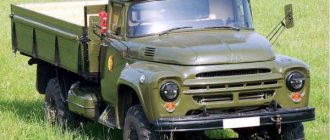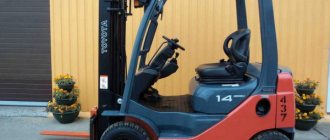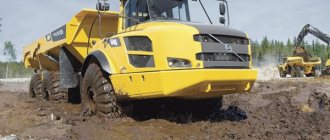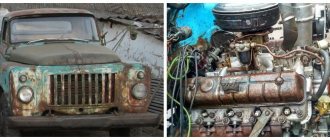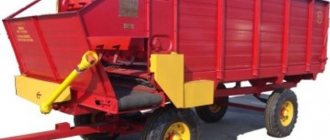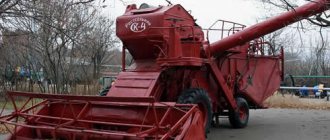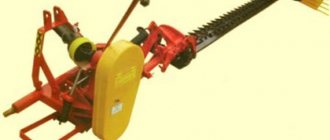One of the most common dump trucks today is ZIL-4331.
It has fairly good cross-country ability, high load capacity, maintainability, and many other advantages. Also, its cost is a compromise compared to many similar trucks.
Most often you can find the ZIL-4331, equipped with a ZIL-645 engine. The most common diesel is used as fuel for this engine.
ZIL-645 is unpretentious and will happily work on any diesel fuel. Its operating and technical parameters are quite impressive:
- working volume – 8.74 l;
- maximum possible power at 2,800 rpm – 185 hp. With.;
- the maximum possible torque on the engine shaft is 510 N×m (at 1,500-1,700 rpm);
- number of working cylinders – 8 pcs.;
- cylinder arrangement – V-shaped;
- number of valves (two for each cylinder) – 16 pcs.;
- number of cycles in one working cycle – 4.
At the moment, the 645 engine model running on a diesel engine is not available, but you can still buy all the necessary components and parts to repair a power plant of this type.
Find out why TYM T233 tractors are the most productive in comparison with domestic machines? And here you will find the main technical characteristics of the MAZ-4370 truck.
Car history
Since 1962, the Likhachev Plant in Moscow has produced a truck for the national economy under the ZIL-130 brand. The truck was extremely popular and practical, but was inferior to its classmates due to high fuel consumption. At the end of the seventies, the plant began developing a more economical model with a diesel engine. Namely, in the 70s, the designers of the Likhachev plant received the task of developing two advanced trucks with different load capacities.
The models were supposed to run on diesel fuel. Initially, the car was designed by ZIL specialists, but after the design was created, the documentation was transferred to Naberezhnye Chelny. In 1986, the first ZIL-4331 began to roll off the assembly line. It was this model that was intended to replace the ZIL-130. Shortly after the launch of the project, the debut version of this model with a double cab was presented, as well as a chassis designed for special vehicles. Later, specialists from the Likhachev plant created a racing version of the truck, which resembled the original only in appearance.
Renault Magnum. Features of electrical equipment
The turning radius, despite the relatively compact dimensions of the car, is 7.8 m, which makes driving the Bychk in the city not always comfortable. However, the launch of the modernized Tapir family with a 4.5-6 t payload capacity, scheduled for 2008, was constantly postponed, which also did not strengthen the competitive position of AMO ZIL.
| Engine | Consumption (city) | Consumption (highway) | Flow (mixed) | Type of fuel |
| 5.6 MT 109 hp (Mechanics) | — | — | 50.0 | Petrol |
Cabin and body
First of all, the appearance of the cabin has changed. It acquired angular, clearly defined outlines without smooth transitions. The body is made entirely of metal and has a common base. However, its layout is not entirely standard. The main difference is that the fenders, hood and front grille are made from one rigid piece.
Access to the engine is provided by lifting this structure up and forward on hinges that are attached to the front bumper on the vehicle's power frame. At the same time, it has become very convenient to repair the engine; access to all engine systems is available. Over time, this method was abolished due to some inconveniences in operation.
In subsequent versions of the model, the hood opens in the usual “alligator” way. At the front of the ZIL-4331 truck, a new front bumper is installed, into which headlights and turn signals are mounted. Moreover, they are structurally located in such a way that there is the least danger of damage in the event of an accidental collision. Inside, the cabin has become more comfortable.
The comfortable driver's seat is sprung and adjustable in all directions. Two passengers can sit side by side. The middle seat lifts up to create a table. The large glass area of the cabin and side mirrors allow you to fully control the road situation.
The ZIL cabin of the “4331” model is equipped with excellent heat and sound insulation, which allows you to talk inside the truck without raising your voice, and also not experience inconvenience due to cold weather. There are three seats, one of them is the driver's seat. One of the most popular was the modification with a berth, which appeared in the early 90s.
The model received a universal bumper “skirt”, fairings on the sides of the body and a drag foiler installed on the roof. ZIL-4331, in comparison with foreign analogues, stood out for its significantly lower cost. In addition to the cabin designed for three people, versions with a 2-row cabin version with 7 seats were also produced.
The ZIL-4331 flatbed body is a wooden platform with metal transverse base bars, with folding rear and side sides. The body design provides for the possibility of installing extension sides and an awning with a frame.
Advanced technologies "MosKarZ"
ZIL had three branches in Moscow: MKZ (Moscow Carburetor Plant), MAAZ (Mironovsky Automobile Unit Plant), MZAA (Moscow Automobile Unit Plant). The carburetor plant had two production sites: the main historical one in Shabolovka and the new one on the outskirts of Moscow in Chertanovo. In addition to carburetors, the carburetor plant also produced gas shock absorbers. Carburetors were made in Shabolovka, and shock absorbers were made in Chertanovo. In Chertanovo, large production areas made it possible to assemble special equipment - manufactured goods vans, fire engines, emergency vehicles.
They started designing fire trucks at MKZ in 1993, not out of luck. Special equipment was created by the factory workers, using everything of their own (chassis, PTO, transmission), except for fire pumps and fire protection equipment purchased at specialized enterprises.
MKZ fire trucks can be recognized by the characteristic logo on the left side of the engine compartment lining (later on the right) and the design features of the body. Although there is no shame in rethinking the successful experience of others, nevertheless, MosKarZ designers did not copy well-known designs of fire trucks, but tried to create their own, to keep up with technical progress and trends in the construction of fire trucks. But they did not advance beyond frame bodies, curtain compartment doors and corrugated aluminum sheets for body elements.
However, this was also progress compared to the archaic folding lifting doors on the first models of tank trucks. Under pressure from complaints about poor quality, curtain doors, which had not proven to be reliable, were abandoned, but were later returned when creating new models of fire trucks. The technical department team of the Chertanovo branch worked on the creation of the machines. Head of the technical department O. S. Zhukov, chief designer E. D. Gusev. Designers: Yu. N. Lyutrov, V. A. Grigoriev, V. I. Romanov, I. A. Lukyanov, V. A. Faleev, O. Yu. Pyleva, P. S. Bykov, V. B. Semenov, V. I. Abroskin, V. I. Popov, L. I. Shchelokova, I. N. Aleynikov, O. V. Pronina, O. Melnikova. Technologists: S. N. Koshkin, V. V. Alyaev.
On the ZIL-4331 chassis
Fire trucks on the ZIL-4331 chassis were destined for a favorable fate; they were mass-produced and, moreover, on the assembly line of the metropolis itself - on ZIL! The idle production facilities of ZIL will be loaded with the production of fire fighting equipment, but not earlier than five years after the start of production at MKZ.
On other chassis
On the ZIL-5301 chassis
Specifications
Engine
It is ZIL-4331 that is considered the founder of the first Russian line of trucks with diesel power plants. Fuel consumption of ZIL 4331 is from 18 l/100 kilometers. If we talk about a road train, then its consumption already starts from 25 liters per hundred.
It is extremely rare, but still, you can find gasoline engines on trucks of the “4331” model.
When operating a car with gasoline engines, consumption is approximately 30-36 liters per 100 km at a speed of 90-95 km/h and may vary depending on the load. Specifications
| Engine | ZIL-645 | ZIL-508.10 | ZIL-508.300 |
| Number of cylinders | 8 | 8 | 8 |
| Number of valves | 16 | 16 | 16 |
| Cylinder arrangement | Longitudinal V-shaped at an angle of 90° | Longitudinal V-shaped at an angle of 90° | Longitudinal V-shaped at an angle of 90° |
| Volume | 8.74 liters | 6 liters | 6 liters |
| Power | 185 l. With. | 150 l. With. | 135 l. With. |
| Maximum speed | 2,800 rpm | 2,800 rpm | 2,000 rpm |
| Maximum torque | 510 Newton meters | 402 Newton meters | 377 Newton meters |
| Dimensions | |||
| Length | 6 370 mm | ||
| Width | 2,500 mm | ||
| Height | 2,655 mm | ||
| Wheelbase | 4,500 mm | ||
| Front track | 1,930 mm | ||
| Rear track | 1 850 mm | ||
| Clearance | 330 mm | ||
| Dimensions of wheels | 7.0-20 | ||
| Wheel type | 9.00R20; I-N142B-1 | ||
| Weight characteristics | |||
| Truck weight | 4,820 kg | ||
| Maximum load capacity | 6 tons | ||
| Weight fully equipped and max. loaded | 11,700 kg | ||
| Weight of one fully equipped wheel | 93 kg | ||
| Engine weight | 720 kg | ||
| Engine weight with all equipment | 960 kg | ||
| Weight of the entire cabin structure | 550 kg | ||
| Maximum load | To the front axle | 3,735 kg | |
| To the rear axle | 8,005 kg | ||
| When using a road train with full suspension | 23,000 kg | ||
| Transmission | |||
| Type | Mechanics | ||
| Number of gearbox stages | 5 | ||
Transmission
The truck is equipped with rear axle drive. It has a single-plate clutch with peripheral springs. We also note that the clutch release drive is equipped with a pneumohydraulic booster.
Chassis
In the front part of the ZIL 4331 there is a pair of semi-elliptical springs with two shock absorbers and sliding rear ends. But at the rear, two main and additional springs of the same type are used.
Device
The device of this vehicle includes such elements as:
- Power unit. It has a gasoline engine equipped with a carburetor and two falling flow chambers. Inside the motor there is a pump element and an economizer, as well as a mechanism for forced idle. The unit is made in accordance with the international environmental standard Euro-0.
- Brake system.
- Electrical equipment, including sound and light alarms, headlights, low and high beams.
- A pneumatic system that makes the car ride smoother.
- Transmission. A manual transmission is installed here. Gear shifting is carried out using a special control lever.
- Clutch mechanism, wheels and tires.
- Front and rear driving axle.
Brake system
There are 2 independent braking systems installed here: one acts on all wheel mechanisms, and the second only on the transmission. The brake system of the ZIL-130 modification was taken as a sample.
The brakes, equipped with a pneumatic drive, are equipped with an air compressor, as well as pistons, a two-cylinder cooling system for the working fluid. Such braking devices are located on the right side of the body inside the car and are driven by a belt-type transmission, which is supplied from the pulley of the water pump element.
All cylindrical mechanisms of the system are made of cast iron and mounted on the crankcase. The piston part is connected to the upper head of the connecting rod using a floating pin.
When the brake pedal is released, the access of the compressed air flow to the chambers is stopped, due to which the vehicle continues to move.
Electrical equipment
The type of system of electrical devices and mechanisms of this vehicle is single-wire. The negatively charged terminals of the current sources are connected to the ground of the ZIL. The rated voltage in the system is 12 V. Low voltage wires of the PGVA type and high voltage wires of the PVV type are used inside the mechanism.
In order to check the serviceability of the insulating coating of the electrical circuit, it is necessary to conduct an external inspection of the electrical equipment. If an open circuit is detected, it is recommended to insulate the exposed low pressure wire with special tape. If the high voltage wire fails, it is necessary to replace it with a new one in accordance with the electrical diagram given in the vehicle repair manual. High voltage wires cannot be repaired.
Pneumatic system
The ZIL pneumatic system includes the following elements:
- compressor with plugs;
- tube leading from the windshield wiper;
- brake chamber;
- tee tube;
- union;
- tap elbow;
- dispensing type crosspiece;
- mounting bracket;
- pressure level regulator in the system;
- bracket;
- hoses;
- clamp;
- safety valve.
Before driving, it is recommended to measure the pressure level in the pneumatic system. It must be at least 4.5 kg/cm². If the indicator exceeds 7.4 kg/cm², it means the pressure regulator or unloading device is damaged.
When you press the brake pedal sharply, the pressure in the cylinders should decrease, and in the brake chambers it should become equal to the pressure in the cylinder. If this does not happen, it is recommended to disassemble the mechanism and conduct an external inspection of the parts for wear.
Modifications
- ZIL-433100 - basic model with a wheelbase of 4500 mm and a ZIL-645 engine;
- ZIL-433102 – standard chassis;
- ZIL-433104 – chassis for fire trucks;
- ATs-3-40(433104) and ATs-40(433362)-63B.01 – fire tankers;
- ZIL-433110 – basic modification with the ZIL-508.10 unit;
- ZIL-433116 – basic version with the ZIL-509.10 power plant;
- ZIL-43314B - long-wheelbase flatbed version with a ZIL-6454 engine with a wheelbase of 6100 mm;
- ZIL-4332A - a special version with an extended wheelbase (5600 mm) and a ZIL-645 engine;
- ZIL-4333 - short-wheelbase modification with a ZIL-645 engine and a wheelbase of 3800 mm;
- ZIL-433302 – short-wheelbase chassis;
- ZIL-433360 – model with a shortened wheelbase and the ZIL-508.10 power plant;
- ZIL-433362 - short-wheelbase chassis equipped with a ZIL-508.300 engine;
- ZIL-442100 – truck tractor with a wheelbase of 3800 mm and a ZIL-645 unit;
- ZIL-442160 – truck tractor with a wheelbase of 3300 mm and a ZIL-508.10 engine;
- ZIL-442300 is a truck tractor with a sleeper and an extended wheelbase (4500 mm).
All versions of the model were characterized by a rear-wheel drive, front-engine layout.
The most popular modification
We are talking about ZIL-4333. The shortened base was produced in the form of a truck and was equipped with three different engines: ZIL-645; ZIL-508.10 and ZIL-508.300. Certain changes added a prefix to the main index.
The appearance and structure were similar to the basic variation, only the length was not 6,370 mm, but 3,800 mm. These models have gained their popularity due to their practical size. It is more convenient to maneuver in city traffic with a shorter vehicle, and deliver cargo faster. Thanks to this, diesel variations 433302, 433360, 433362 are still produced.
Index confusion
In addition to the departmental designation, for example ATs-3.2-40, fire engines created at MKZ and even at ZIL did not have their own index in the first months. It turns out that only factory specialists could identify the fire truck based on the design elements, configuration and modification of the base chassis. The model number, familiar to other manufacturers of fire trucks, which meant everything, was forced to be formally assigned to ZIL, but this did not bring clarity, since the MKZ and ZIL vehicles were the same.
In the history of the plant. Likhachev there are examples when different machines were built under the same designation. This was explained by the fact that ZIL is a mass production plant for cars. A model accepted for production was assigned a number, a full set of design and technological documentation, equipment, etc. was developed. When a model was rejected (did not go into production), the number was used for another machine, making life easier, since each new number must be agreed with US.
There was information that the plant was allocated a limited number of rooms, but we believe that this problem for a well-known enterprise is far-fetched, since there were no complaints about a shortage of rooms here. It turned out that in market conditions, for the registration and state registration of each new model number, it is necessary to pay money, and a lot of it.
At first, ZIL even worked under the certificate of the Moscow Carburetor Plant, fortunately, there was complete continuity between the enterprises. Note that for internal production use, in addition to the main six-digit digital number of the chassis model, there was a ten-digit number of the consumer configuration of the product, which took into account everything, including the composition of the PTV. The usual ZIL product designation system was not violated with the release of new products that were not typical for the plant. If the customer’s requirements changed, then a new consumer license plate set was immediately created. The model number is formally required for registration of specifications, MVK and form. During the production process, the car was modernized and changes were made, however, the model number remained the same! They did not stand on ceremony with the prototypes at all; there is no mass production, which means that documents and a model number are not needed.
The list of types of fire-fighting equipment mastered by enterprises is small, there are only six of them: AC - a general-purpose vehicle, AA - an airfield vehicle, ATSU - a simplified type vehicle, AD - a smoke removal vehicle, AGDZ - a gas and smoke protection vehicle, MLPC - a small forest patrol complex.
Advantages and disadvantages
- The main advantages of the ZIL-4331 vehicle are excellent maneuverability and impressive load capacity.
- A reduced number of chassis lubrication points and automatic brake adjustment help reduce time and money spent on service work.
- Today, ZIL-645 engines are no longer produced, but it is quite possible to purchase spare parts for engine repair at fairly reasonable prices.
- The plumage of the first copies of the ZIL-4331 was integral. For this reason, if the truck frame became skewed, problems arose with closing the hood.
- Good interior seal.
- The presence of seat belts on all seats.
Despite excellent reviews and a lot of positive aspects, this model is not popular in Russia. Thus, this truck cannot seriously compete with foreign analogues due to its rather high fuel consumption and low load capacity. But the ease of repair and low cost make the car in question extremely popular in some areas of industry.
Purpose
The main area of application of the ZIL-4331 was regional transportation over short distances. The car is distinguished by reliability, ease of maintenance and repair, as well as low operating costs. It can be confidently called a “workhorse” for various industries, agriculture, logging, and housing and communal services. The car feels confident on sticky soils and steep climbs. The car performed well not only in various climatic zones of Russia, but also in subtropical and tropical climates. ZIL-4331 is equally reliable both on flat terrain and in high mountain areas. About one and a half million ZIL-4331 units are in operation in Russia and countries of the near and far abroad.
Let's sum it up
Having completed production of ZIL-4331 in 2004, the manufacturer did not leave the car without a means of subsistence. Thanks to this, the truck remains popular due to its ease of maintenance. Of course, the power units are quite uneconomical and the load capacity is relatively small, but this does not prevent the car from still being popular in many areas.
When purchasing this model, you will have to fork out an amount of 200 to 2500 thousand rubles. In this case, the buyer receives a version produced in 1995-2004 with low mileage and in excellent condition. All that remains is to ensure quality care and use all the positive aspects of this car.
We advise you to read the article: ZIL - the history of the auto giant
Advantages
Bypass pressure reducing valves are installed in the housing of the liquid-oil heat exchanger 11 with a response pressure value of 0.15-0.20 MPa and in the oil filter 13 with a response pressure value of 0.13-0.17 MPa. L37198 Italy and other companies that have anti-drainage and bypass valves in their design with main overall dimensions: diameter 95-105 mm; height 140-160 mm; thread 3 4-16UNF.
ZIL-4331
Read further:
UAZ “Profi” 2018-2019: what was updated a year later?
MAZ-200
Such a compact Jeep Renegade
Chevrolet Silverado HD will be released in the USA in 5 design options
KamAZ-6520
Updated Jaguar F-Type: first photos
Forced conversion
Struggling for survival, the plant fulfilled even unpredictable orders. One day a paper arrived: “In order to eliminate the debt for consumed natural gas, we ask you to manufacture fire trucks with the following configuration...” - and then the list followed. Thus, the State Unitary Enterprise Mosgaz received vehicles intended for emergency work, but assembled on the basis of a fire engine body.
Fuel consumption
For gasoline modifications, fuel consumption at a speed of 90-95 km/h is 26-30 l/100 km. However, it may vary depending on the load.
Without a load, at a speed of 60 km/h, the ZIL-4331 requires about 18 liters of gasoline per 100 km. When the speed increases to 80 km/h, the figure increases to 23 hp. As part of a road train, for every 100 km of travel, the truck consumes 25 liters at a speed of 60 km/h, 32 liters at a speed of 80 km/h.
The fuel tank ZIL-4331 holds 170 liters.
Unrealized power
ATs-5.0-40 (640904) the vehicle was not included in the factory nomenclature, since by the time the assembly of the prototype was completed, the plant’s model strategy had changed. V. Nosov’s ideas to expand the standard range of models, in particular the creation of three-axle all-wheel drive vehicles with a gross weight of 20 tons or more, as well as a fire tanker on a 6x6 chassis with an original transfer case, were not implemented. With the arrival of K.V. Laptev, who banned the 133 family, the machine was completely at a crossroads, production was out of the question, and the equipment was sent to scrap.

